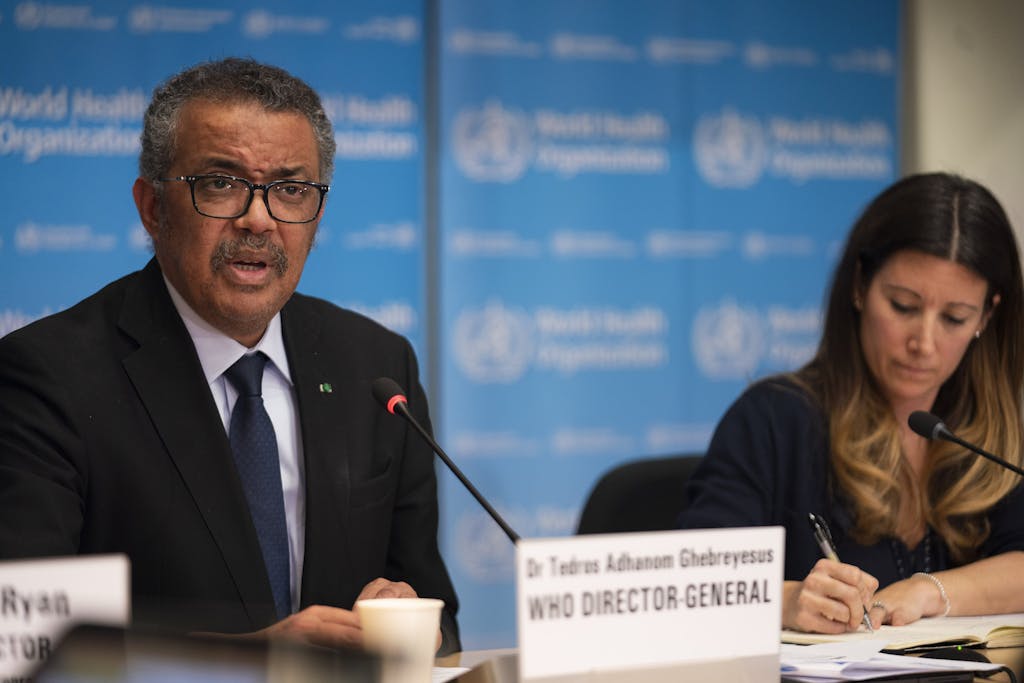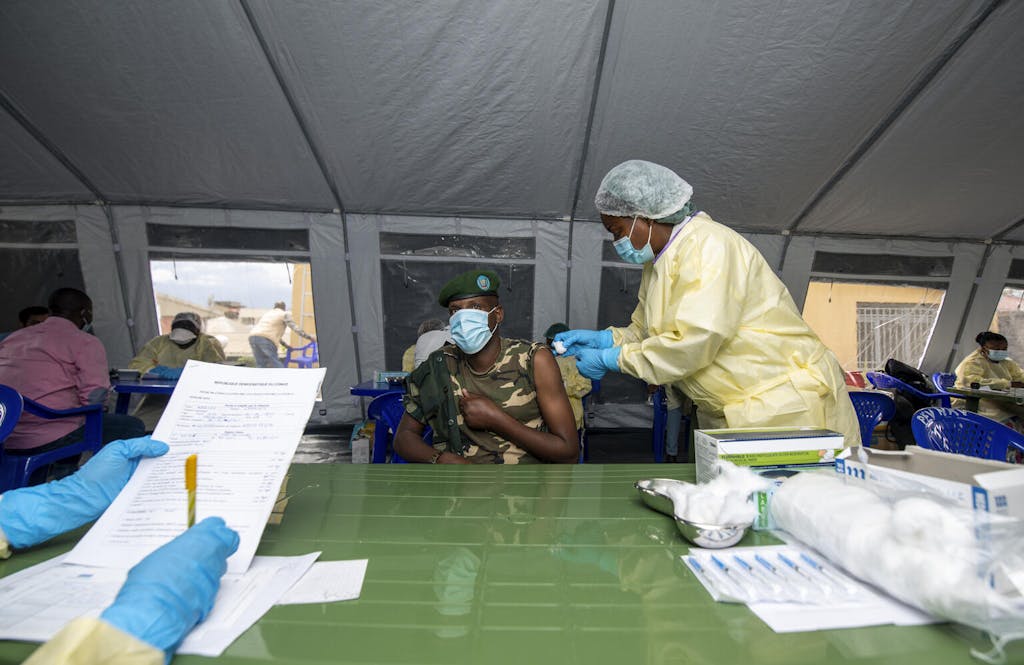As the decision-making body of the World Health Organization, the World Health Assembly has taken on renewed significance in recent years amid the COVID-19 pandemic. This year’s convening — the Assembly’s 75th — will determine WHO’s leadership for the next five years and accelerate progress on priorities that are critical to the health of not only WHO as an organization, but also to the health of all people, everywhere.
The world just marked yet another grim milestone in the ongoing fight against COVID-19: nearly 15 million deaths recorded worldwide. It’s against this backdrop that delegations from all 194 World Health Organization (WHO) Member States will convene at the 75th World Health Assembly. Held annually at the end of May, WHA will take place in person in Geneva this year for the first time since the pandemic began. In addition to electing the next Director-General, this year’s convening is expected to be an important forum for high-level discussions on sustainable financing and reform of WHO as well as on preparedness, response, and resilience to health emergencies — including future pandemics.
Below are the key details to watch on these three critical issues topping the WHA agenda this year.
1. THE DIRECTOR GENERAL’S VISION FOR WHO’S FUTURE
Leadership of the world’s preeminent health agency will be decided during this year’s WHA. Dr. Tedros Adhanom Ghebreyesus is running uncontested for a second term as Director-General after leading WHO through an unprecedented global pandemic. Assuming he is reelected, Dr. Tedros is expected to share his vision and lay out a plan for the next five years. At the WHO executive board meeting in January, the Director-General said that the agency was committed to dramatically strengthening its ability to deliver results at the country level. At the core of Dr. Tedros’ vision is the need to seize the lessons of the pandemic to transform WHO’s ways of operating by focusing on primary care, prevention, and well-being; strengthening capacities for preparedness and response to health emergencies; harnessing science and innovation to drive progress; and strengthening WHO as the directing authority on global health.

Dr. Tedros Adhanom Ghebreyesus, Director-General of the World Health Organisation (WHO), speaks at a press conference. Photo: WHO
2. SUSTAINABLE FINANCING OF WHO
WHO has been chronically underfunded for years, which has become especially apparent as the world has turned to it for leadership during the pandemic. Overall, WHO’s budget is on a par with that of a midsize hospital in Geneva, and there have been no major improvements to WHO’s financing model in decades. One of the agency’s main obstacles is that countries’ mandatory membership dues (known as assessed contributions) account for only 16% of its base budget, hindering its ability to plan and to attract the best scientific talent. WHO is forced to rely on unpredictable and often earmarked voluntary contributions. As a result, each of the more than 2,000 grants it is managing has different funding limitations, reporting requirements, and grant management costs.
The WHO Working Group on Sustainable Financing (WGSF) has been tasked for over a year with finding a solution to this problem. In late April, the group reached a significant agreement to increase assessed contributions to cover 50% of the base budget by 2030. If approved at this year’s WHA, the first incremental increase would take place in 2023. These increases are conditioned on ongoing WHO reforms that have been demanded by Member States, particularly budget transparency, efficiency, and accountability.
The consensus achieved by the Working Group in April is a positive signal that Member States will support the passage of the recommendations for sustainable financing for WHO during the WHA in Geneva. However, this is not a given. Should the recommendations be adopted, it could have a multiplying effect throughout the global health sector and beyond. A recently published WHO investment case points out that investments in WHO produce an economic return of 35 U.S. dollars for every dollar invested.
3. PREPARING FOR AND RESPONDING TO FUTURE HEALTH EMERGENCIES
At the 74th WHA and the historic Special Session in 2021, Member States agreed to establish an Intergovernmental Negotiating Body (INB) to work toward the creation of a Pandemic Accord and the Working Group on Strengthening WHO Preparedness and Response to Health Emergencies (WGPR). While the INB is not expected to meet again until early June, the WGPR will present its recommendations to the WHA with proposed actions for Member States. Of particular interest will be whether the Assembly takes up any amendments to the International Health Regulations, the current legal framework the world uses to reduce the spread and impact of outbreaks of infectious diseases. Proposals from Member States on how to strengthen regulations are still under development, so it remains to be seen whether this Assembly takes forward any concrete changes.

At a provincial hospital of North Kivu, a nurse administers the first dose of the COVID-19 vaccine to Kagigi Charles, a 45-year-old soldier in the Democratic Republic of the Congo. Photo: Arlette Bashizi/ UNICEF
While these processes will certainly be central to the Assembly, other issues related to strengthening preparedness and response to health emergencies are also likely to appear — namely, Member States’ concerns about coherence and demands for a stronger blueprint for how WHO and other multilateral bodies will work together to manage future threats. WHO will put forward its own vision for strengthening these capacities through the Director-General’s report, Strengthening the Global Architecture for Health Emergency Preparedness, Response and Resilience (HEPR), which intends to provide a new overarching integrated framework for all the health emergency reforms and processes underway and the role of WHO.
OTHER GLOBAL HEALTH ISSUES ON THE WHA75 AGENDA
With the intensity of effort on health emergencies and pandemics, it can be easy to overlook the hugely diverse mandate that the upcoming Assembly will have on a range of issues with direct implication for the health and well-being of people around the planet. The rise of noncommunicable diseases, prevention of obesity and harmful use of alcohol, the pathway to polio eradication, progress toward Immunization Agenda 2030, and promotion of mental health all will feature prominently.
Improving the health care workforce will also be an important topic of discussion with particular focus on a report summarizing progress in the implementation of the WHO Global Strategy on Human Resources for Health: Workforce 2030 adopted by the Assembly in 2016.
The long agenda for WHA75 reflects the tremendous breadth of WHO’s enormous mandate — a mandate that it may not have the funds to meet unless a sustainable financing solution is adopted when Member States convene later this month.
Learn More about WHA75
Plan ahead for WHA, and gain access to unofficial side events open to the public.







